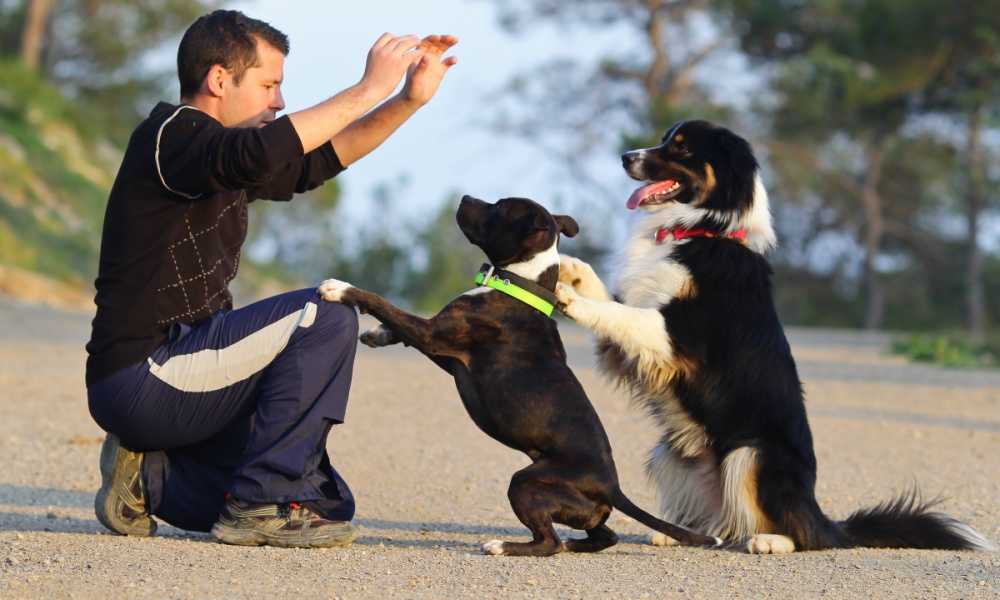Dog Training Commands List
Wondering how to get your dog to do those tricks you see on YouTube? Or maybe you’re curious to know if you’ve covered all the basics in dog training classes?
Dogs can learn many commands, but not all of them are necessary for your dog’s well-being. However, many of them are fun to learn.
If you’re ready to expand your dog’s command repertoire, we have created a dog training commands list that you can follow, as well as provided some important tips to keep in mind when training your dog. When dealing with behavioral problems though, you can check out the Brain Training for Dogs since it gives pieces of great advice for a variety of dog issues.
The Basics: 10 Commands Every Dog Should Know
Those included in the advanced dog training commands list aren’t necessary to have a well-behaved dog, but they are impressive to use. They may also offer additional mental and physical stimulation to your canine as they learn more things.
Here are 20 relatively advanced commands to teach your dog:
- Walk backward
- Walk faster
- Watch me
- Wait
- Down head down
- Put away
- Fetch
- Find it
Commands from a Distance
- Eliminate (potty) on command
- Leave it
- Hold it
- Drop it
- Touch or target
- Quiet
- Speak
- Turn left
- Turn right
- Heel
- Walk slower
Just like basic commands, these may not necessarily be the exact words you use, but the commands are the same. On the other hand, giving commands from a distance may not be an exact command, but it’s still an achievement and an advanced technique if you can get your dog to listen from afar.

Special Dog Tricks: 20 Commands for a Wonder Dog
This list isn’t really for your dog’s manners; instead, these fun tricks may help you and your family form a stronger bond with your canine friend. Some of these commands include:
- Kiss
- High five
- Wave goodbye
- Shake yourself
- Jump over
- Shake hands
- Say your prayers
- Sit pretty
- Bow
- Handstand
- Peekaboo
- Play dead
- Roll over
- Tuck yourself into bed
- Spin
- Yawn
- Weave through legs
- Limp
- Crawl
- Moonwalk
Tips for Effective Learning: Different Ways of Giving Commands
1. Use Hand Signals
Did you know your dog is more of a visual learner? So you may want to try incorporating simple but unique hand signals to go with every command. Additionally, using hand signals as communication may be another way to build confidence and trust with your pet.
There isn’t a list of official hand signals; just use anything that feels natural. Do note though that you should be consistent, especially since this is another language you and your dog are learning together. Also, remember to reward your canine buddy when they perform correctly.
2. Use Verbal Cues
Do you have a noisy household? If your dog hears talking all day long, how will he know you are giving him commands underneath all the blah-blah-blah?
Try issuing commands in another language, but of course, this is more effective if the language is not commonly spoken around them. For example, if they live in a Spanish bilingual household, German commands may stand out.

Tips for One of the Biggest Command Hurdles: Recall
When your beloved pet gets off-leash, do they run off into the sunset? Are you paranoid about him ever getting out without a leash? When your dog comes when you call, it can be a lifesaver for both you and your pet.
Unfortunately, it’s also one of the most difficult commands to master. Sure, they may listen to you in the safety and seclusion of your home, but what happens when they are out in the open?
To get your dog to come back, you need a lot of patience and apply some a few secrets about teaching recall as suggested by certified trainers:
- Food bribery is okay: Keep tasty treats and positive reinforcement handy every time you train your dog.
- Be in control at all times: Always train with a long leash if needed.
- Set your dog up to win: Never issue commands when the dog is tired or distracted.
- Keep commands clear and simple: Dogs can easily recall the command if you’ll use a simple word or a short phrase.
- Try to mix up the rewards: Giving them a variety of rewards will encourage them to obey since they will look forward to what they will get next.
- Consider trying commands when they are hungry: Dogs are always willing to work for food.
Many of these tips may also help when teaching your canine pal other new commands. They may seem like common sense, but these tips work consistently. If you want more in-depth tips for doggy training, you may want to check out Brain Training for Dogs.
Final Thoughts
Training your dog to follow commands not only helps you but your dog as well. The process of training and achieving different command levels may increase your bond with your pet, as well as give them a better sense of well-being. In a way, your canine pal is happy that they understand what you want, and similarly, you’re happy that the dog is so well-behaved, making it a win-win situation.
In addition, training doesn’t have to stop once you master the basics. Keep working through the dog training commands list. Your dog may welcome the challenge and further interactions with you. In the end, you just might teach your dog something useful or entertaining.
The great thing today is that you don’t have to bring your dog into training classes every time you want to level up the commands they understand and follow. Simply browse through the Brain Training for Dogs for tips and pieces of advice. What is better is that in case you’re really overwhelmed, the creator offers personal consultations.

